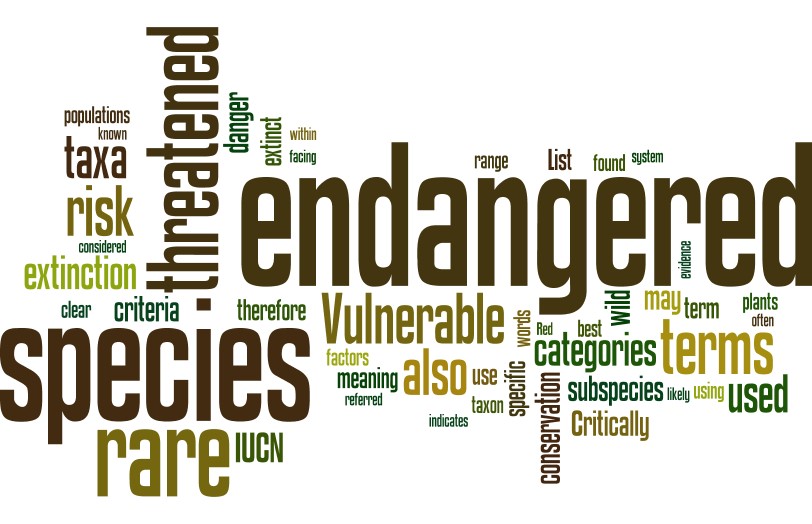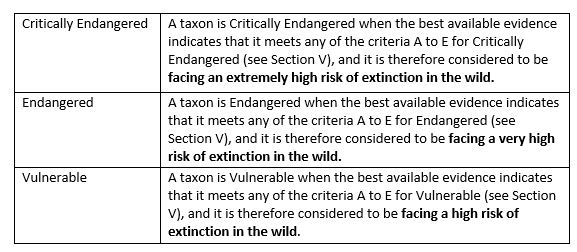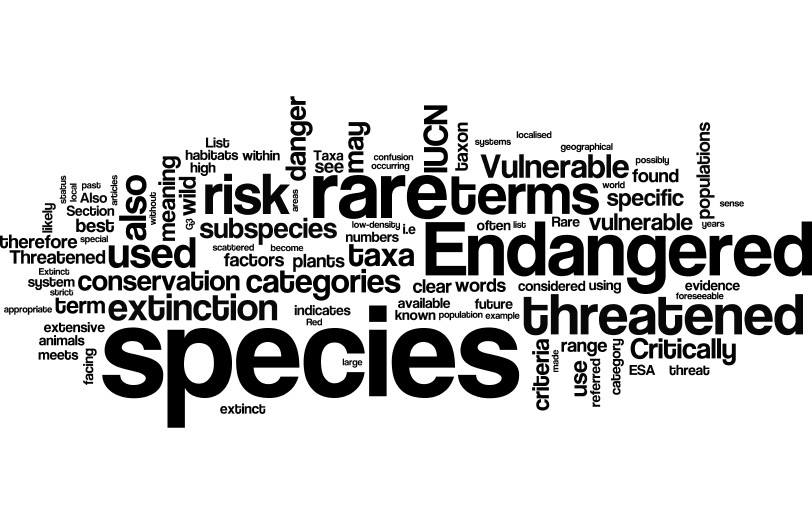Coming to terms with the terms
-
Programme
Global Trees Campaign -
Workstream
Sharing Knowledge and Resources -
Topic
Tree Conservation -
Type
Blog -
Source
BGCI

The Global Trees Campaign works with the conservation of threatened trees, but what does it mean to be threatened, rare, at risk, endangered or vulnerable? How are the terms used? Why is it important to distinguish between them? This technical blog will shed light on some of the confusion around these terms, and may be helpful if you are prioritising species for a conservation project, writing a grant proposal, communicating the needs of particular species to policy makers, or even doing a red list assessment.
Terms such as threatened, rare, at risk, endangered or vulnerable are used extensively in the conservation literature, both in peer-reviewed journal articles and proposals, and in popular articles and newspapers. Sometimes these terms are used interchangeably to describe any species needing conservation action to ensure its survival. Therefore, a threatened/rare/ at risk/endangered/vulnerable species is not just any species, but indicates a species with special value that we should care about. However, in many other instances, these terms have very specific meaning and are used to communicate very specific concepts. Using these terms interchangeably can therefore cause confusions to whoever you are trying to communicate to (whether it be a funder or a policy maker).
One of the most well-known systems for classifying extinction risk for different species (and the one used by GTC) is the IUCN Red List Categories and Criteria. The Global Trees Campaign uses the IUCN Red List Categories and Criteria to prioritise conservation action and to communicate which tree species are at greatest risk of extinction. We use the IUCN Red List because it is the most widely used system, and has standards and known definitions used to quantitatively assess extinction risk. As a result, it can be used to compare conservation statuses between both species and geographical regions. The Global Trees Campaign and partners are currently assessing all the world’s trees in the Global Tree Assessment (www.globaltreeassessment.org) to identify which tree species are most at risk of extinction.
In the IUCN Red List, the terms Critically Endangered, Endangered and Vulnerable have very specific definitions and meanings (Table 1). For example, a Vulnerable species has fulfilled a specific set of criteria indicating that this species is classified as Vulnerable, and it would be misleading and incorrect to describe this as Endangered. Under this system, any species falling under the Critically Endangered, Endangered and Vulnerable categories can also be referred to as “threatened”.

Other non-IUCN systems also exist, one such classification system is that used by Nature Serve, primarily applied to North American species. NatureServe Global Conservation Status uses ‘G-ranks’, where G1, G2 and G3 are the three ranks for species at risk of extinction. Using such numbered or coded rank can be less clear, unless the exact definition of such a code is known.
Dictionary and legal definitions
There is a clear benefit to the Nature Serve system, where the names of the categories are codes (i.e. G1, G2, G3) with a clear definition, and do not consist of terms/words already in the English (or other) language with their own dictionary definition. In the dictionary for example, endangered is defined as “seriously at risk of extinction” – which is slightly different to the IUCN Red List definition of Endangered (Table 2).

To add to the confusion, the terms threatened and endangered can also have legal definitions, such as under the Endangered Species Act (ESA) in the US, and these definitions differ to those used by IUCN. Under the ESA, species may be listed as either endangered or threatened. “Endangered” means a species is in danger of extinction throughout all or a significant portion of its range. “Threatened” means a species is likely to become endangered within the near future. These definitions differ from those of IUCN Red List.
Endangered species (E) are animals and plants that are in danger of becoming extinct.
Threatened species (T) are animals and plants that are likely to become endangered in the foreseeable future.
Rarely use rare
Another term that is worth mentioning here is rare. The category Rare was a formal IUCN category before 1994, but has since been superseded by the categories described above (Table 1). The difficulty with the word rare is that it, once again, can have several possible meanings.
In the dictionary rare is defined as “not occurring very often” and “not found in large numbers”. Rare can therefore refer to both a species with a restricted geographical range or scattered in low numbers over a more extensive range. Also worth noting that, rare species are not always at risk of extinction and many species are naturally rare (occurring in low numbers or low densities). Therefore, unless the type of rarity that is meant by “rare” is made clear – it is safest to rarely use rare.

Recommendations
A practical recommendation is to capitalise terms such as Critically Endangered, Endangered, Vulnerable if using them in the strict sense as defined by a certain system such as the IUCN Red List. Whereas, use lower case words if we are using them in a general sense without a strict definition. To avoid confusion, we also recommend choosing the terms with care, especially words such as rare and endangered which have multiple meanings and interpretations for different audiences.
In summary, if you are reading about species in the conservation literature or want to communicate the species targeted by your own conservation project (e.g. when writing funding applications, talking on social media, writing a newspaper article, etc.), it is important to understand the terms and words that are chosen to describe endangerment and threat. Choosing the right terms will help to ensure your message is accurate and clear for your audience.
References and resources:
IUCN Red List of Threatened Species (www.iucnredlist.org)
Nature Serve (www.natureserve.org)
Global Tree Assessment (www.globaltreeassessment.org)
How to Red List a Tree (https://www.bgci.org/resources/bgci-tools-and-resources/how-to-red-list-a-tree/).
ThreatSearch (www.bgci.org/threat_search.php)
This blog was written by Malin Rivers for the GTC website. Malin is the Head of Conservation Prioritisation at BGCI, working on various Red Listing projects and is the secretary of the Global Tree Specialist Group.
Support BGCI
You can support our plant conservation efforts by sponsoring membership for small botanic gardens, contributing to the Global Botanic Garden Fund, and more!
Become a Member
Be part of the largest network of botanic gardens and plant conservation experts in the world by joining BGCI today!